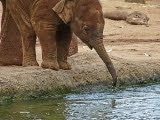Roar. Croak. Meow. What’s that sound? Animals! With the 2011 Institutional Animal Care and Use Committee (IACUC) Conference right around the corner, the stars have aligned. Not only was the March 15 edition of the New York Times’ “Science Times” devoted to our animal friends, the issue also mentioned the research of 2011 IACUC Conference keynoter, Hal Herzog. So read on, get the conversation started, and prepare for a roaring good time as we celebrate animal care and use in Chicago. And, not to worry human subjects researchers, there’s a little something tucked in here for you too!
Week of March 15, 2011
The cre ature connection: Researchers and scientists, including upcoming keynoter Hal Herzog, attempt to explain the diverse and complex relationships that exist between humans and animals.
ature connection: Researchers and scientists, including upcoming keynoter Hal Herzog, attempt to explain the diverse and complex relationships that exist between humans and animals.
For whom the cell mutates: The origins of genetic quirks: In Key West, at the former home of Ernest Hemingway, an analysis of preaxial polydacylous cats confirms scientists’ suspicions.
Forget the treadmill. Get a dog: A recent study from Michigan State University echoes other research that suggests that dog ownership increases an individuals’ physical activity by an average of 30 minutes a week.
Supremacy of a social network: A researcher from the University of Montreal ex plains the role of natural selection in the development of a social infrastructure in chimpanzees and, subsequently, humans.
plains the role of natural selection in the development of a social infrastructure in chimpanzees and, subsequently, humans.
No face, but plants like life too: One long-time vegetarian questions widely held assumptions about the consumption of plants.
Week of March 22, 2011
Riddled with metal by mistake in a study: Breast cancer patients were inadvertently left with traces of tungsten in their bodies following the use of a surgery device. The implications of the metal’s presence in the body remain unknown.
Tortoise and hare, in a laboratory flask: Scientists, using E. coli bacteria, are able to observe natural selection and mutations that impact evolution.
Older ele phant matriarchs keep the lions at bay: The link between age and wisdom is evidenced in the habits of African elephants that have demonstrated that older elephants are more adept at fending off predators.
phant matriarchs keep the lions at bay: The link between age and wisdom is evidenced in the habits of African elephants that have demonstrated that older elephants are more adept at fending off predators.
…And, because we couldn’t resist, one scintillating article from this week’s Boston Globe:
Patients take on expanded role: At the Massachusetts Biotechnology Council’s annual meeting, researchers and physicians discussed the newest trend in the field, “participatory medicine.”

For the next "Science Times" post I must beg you to feature the 4 April article Extending Worms’ Lives, and Maybe Ours. My first biomedical research job was in a "worm lab," and I am still in love with and in awe of these creatures which have taught us so much about Earth genetics, and will continue to for every foreseeable future. It's a beautiful thing that life is so similar to life.
Please also point people towards the really fun popular science book about worm research and worm researchers, In the Beginning Was the Worm.